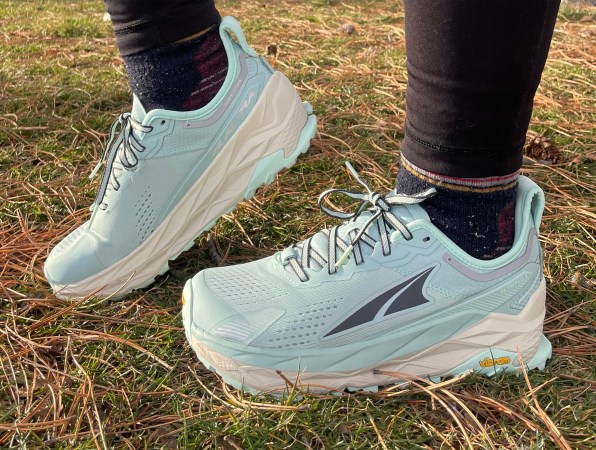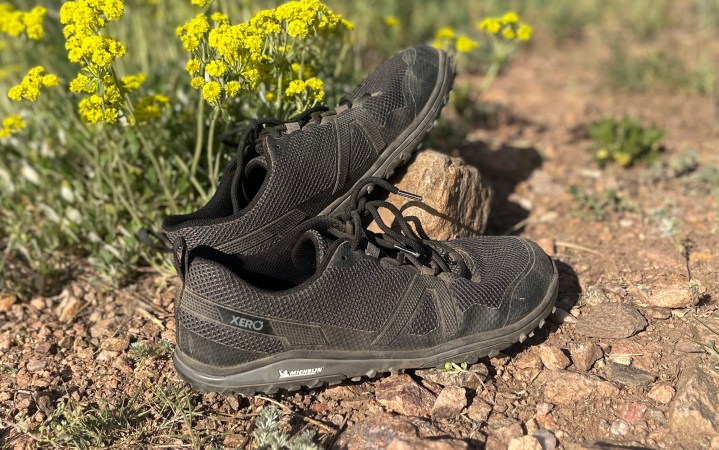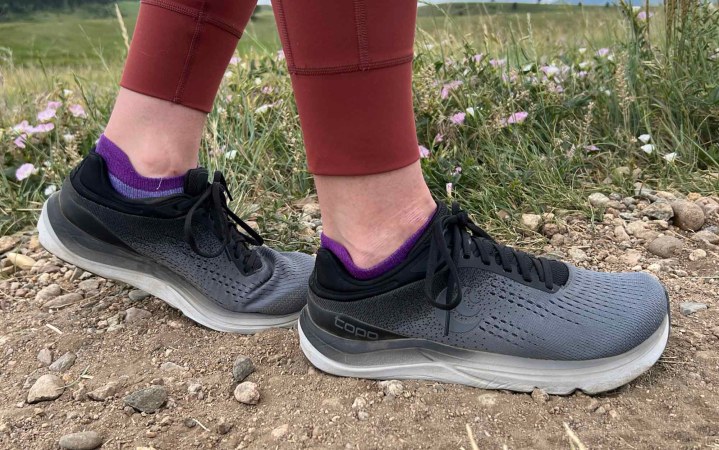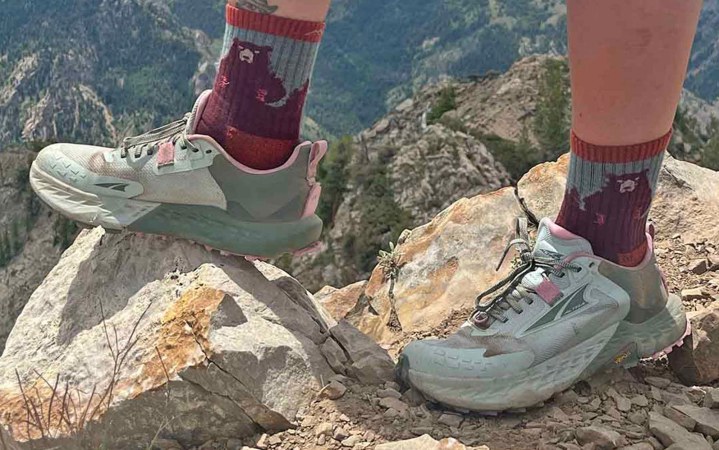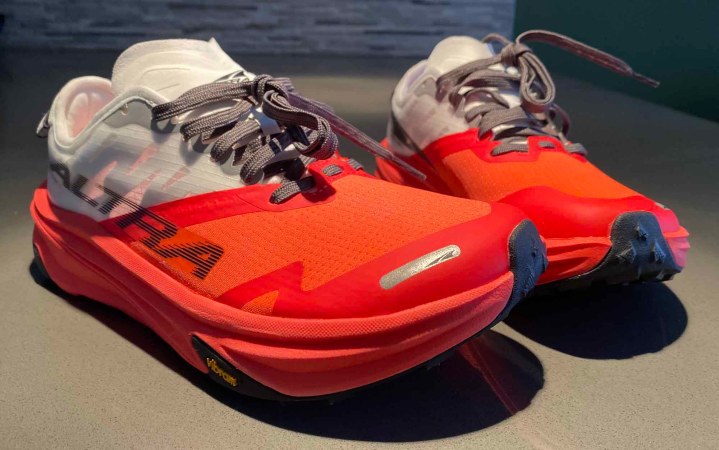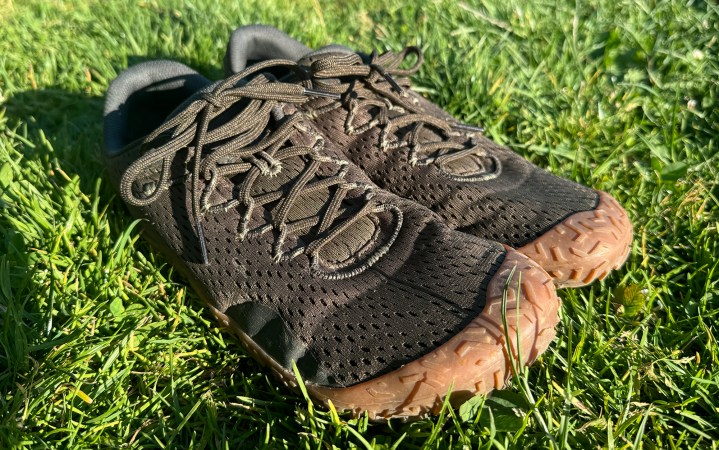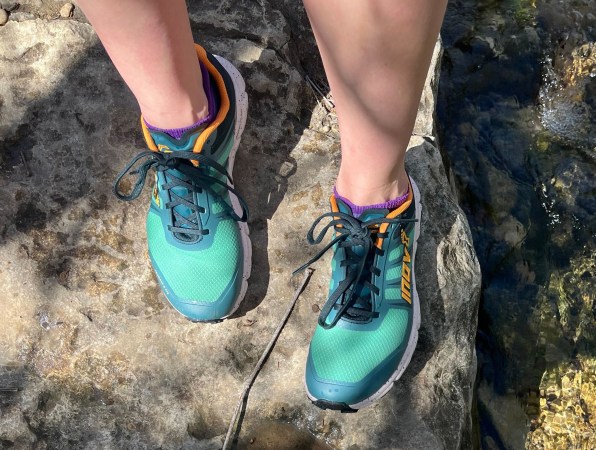The Best Zero Drop Running Shoes of 2024, Tested and Reviewed
We may earn revenue from the products available on this page and participate in affiliate programs. Learn More ›
If you’ve been looking to improve your running form, it might be time to check out the best zero-drop running shoes. Unlike the majority of running shoes, zero-drop shoes do not have any extra cushion or lift at the heel. Turns out that, for many people, when you put your foot on a level plane with the ground, it translates to more efficient, pain-free running. We put seven testers with a range of running goals and preferences in the best zero-drop running shoes from Altra, Xero, Topo, Inov-8, and Merrell. Here’s what they had to say.
- Altra Lone Peak (Men’s) (Women’s)
↓ Jump to Review - Most Cushioned: Altra Olympus (Men’s) (Women’s)
↓ Jump to Review - Best Minimalist: Xero Scrambler Low (Men’s) (Women’s)
↓ Jump to Review - Best Support: Topo Magnifly 5 (Men’s) (Women’s)
↓ Jump to Review - Best for Trail Runs: Altra Timp 5 (Men’s) (Women’s)
↓ Jump to Review - Best for Big Miles: Altra Mont Blanc Carbon (Men’s) (Women’s)
↓ Jump to Review - Best Barefoot: Merrell Vapor Glove (Men’s) (Women’s)
↓ Jump to Review - Best Traditional: Inov-8 Trailfly G270 (Men’s) (Women’s)
↓ Jump to Review
What Is Heel Drop? (And How It’s Different from Stack Height)
People often treat heel drop and stack height as synonyms, but when it comes to shoe geometry, they mean very different things. The drop of a shoe refers to the difference in height between the toe box and the heel. Stack height refers to the height of the shoe between the bottom of your foot and the ground, typically measured at the midfoot. So if a shoe has 27mm of cushion at the heel but only 22mm of cushion at the toes, it would have a 5mm heel drop. A shoe with 27mm of cushion at the heel and 27mm of cushion underneath the toes would be zero drop.
Subtle changes in heel drop and stack height can have outsized effects on your running form and experience. A large heel drop reduces the load on the Achilles tendon, which wraps around to connect your calf to your heel. Reducing the load on the Achilles tendon can, however, put more strain on your hips and knees — it can also shorten your Achilles tendon over time. Large heel drops also contribute to heel striking when running. Conversely, runners in zero drops will tend more toward midfoot and forefoot striking. Their Achilles tendon can also store and release more energy as it lengthens and contracts.
The effect of stack height is more straightforward. In almost all cases, shoes with higher stack heights have more cushioning, and those with low stack height have little or no cushion. Shoes with a lot of cushion in them will block your feeling of the ground. That can reduce foot fatigue, but it also tends to lead to harder foot strikes, which, paradoxically, can make your legs tire out faster than they would otherwise. Runners in shoes with minimal or no cushion will tend to strike the ground more lightly, which reduces strain on the knees and hips. However, feeling every rock and root underfoot is not for everyone. Most people opt for a shoe with a stack height in the mid range.
Zero-drop shoes come in a wide range of overall stack heights, from 6mm to 33mm. Below are the zero drop shoes that were tested as a part of this story, in declining order of stack height.
| Zero-Drop Running Shoe | Buy It | Price | Weight | Fit | Stack Height | Arch Support | Sole | Toe Box | |
| Altra Olympus 5 | Men’s | Women’s | $170 | 12.3 oz | Very wide | 33mm | Some | Minor toe Spring | Very Wide |
| Altra Mont Blanc Carbon | Men’s | Women’s | $180 | 9.9 oz | Wide | 30mm | No | Toe spring | Very Wide |
| Altra Timp 5 | Men’s | Women’s | $155 | 9.8 oz | Wide | 29mm | No | Toe Spring | Very Wide |
| Topo Magnifly 5 | Men’s | Women’s | $135 | 8.7 oz | Wide | 25mm | Yes | Toe Spring | Wide |
| Altra Lone Peak 8 | Men’s | Women’s | $140 | 10.7 oz | Very wide | 25mm | No | Level | Very Wide |
| Inov-8 Trailfly G270 | Men’s | Women’s | $170 | 9.5 oz | Narrow | 22mm | Yes | Toe Spring | Standard |
| Xero Scrambler Low | Men’s | Women’s | $150 | 9.2 oz | Very wide | 19mm | No | Level | Very Wide |
| Merrell Vapor Glove | Men’s | Women’s | $100 | 4.6 oz | Standard | 6mm | No | Level | Wide |
How I Tested the Best Zero-Drop Running Shoes
There are a few obvious candidates for the best zero-drop running shoes. Altra has been dominating the space for years. Barefoot shoe companies like Vivobarefoot and Xero are staunchly zero-drop. But who else? Figuring out what zero-drop shoes were on the market turned out to be trickier than I expected. Very few brands allow you to drill down by drop on their website. When queried, Hoka, Salomon, Brooks, Saucony, and La Sportiva all responded that they had no zero-drop running shoes in their lineup. Brands that do include: Altra, Inov-8, Merrell, and Topo.
The testers for this story came from a variety of backgrounds, running on trails and pavement around the Pacific Northwest, Utah, Arizona, and Texas. Some exclusively ran in barefoot-style shoes; some had never used a zero-drop shoe before. A few were training for ultras; others ran only casually. They ranged in age from mid-20s to early 40s, with some dealing with persistent injuries and others who are injury free.
After talking through the options with each tester, they were paired with a zero-drop running shoe that was new to them (in almost all cases, the brand was also new to them) and aligned with their preferences, biomechanics, and running goals.
Best Zero-Drop Running Shoes: Reviews & Recommendations
Altra Lone Peak
Specs
- Available Sizes: Men’s 7-16; women’s 5.5-12
- Wide option available
- Fit: Very wide
- Stack Height: 25mm
- Arch Support: No
- Toebox: Very wide
- Sole: Level
Pros
- Comfortable for a wide variety of foot shapes and sizes
Cons
- Less cushioning compared to traditional running shoes
- Durability issues
If there is one running shoe that has come to define the zero-drop space, it’s the Altra Lone Peak. Altra appeared on the running shoe scene around the same time as the original barefoot running trend took off, and their shoes shared many of the same qualities: a wide foot bed so that your toes can splay naturally, a lower stack height so you can feel some of the ground beneath your feet, no arch support, and no height differential between the ball of the foot and the heel.
For some people, the Altra Lone Peaks were a revelation: a shoe that felt like wearing no shoe at all. Their stride changed. Persistent knee problems vaporized. That was the case for OL’s gear editor in our review of the Altra Lone Peak 6.
But the Lone Peaks have also been controversial. The combination of a zero-drop with no built-in arch support made it a tough transition for people accustomed to modern running shoes.
Barefoot runners say that the 25mm stack height — more than double what most barefoot shoes have — is blocking out too much ground feel to allow for proprioception, how the nerve endings in your feet detect and respond to changes in the ground. Conversely, the maximalist crowd sees the cushioning of the Altra Lone Peak as unforgivably thin, leading to bruised and battered feet. And with growing durability and fit issues with each new model, even the once-committed Altra Lone Peak crowd is starting to look for zero-drop alternatives.
Most Cushioned: Altra Olympus
Tester Report Card
- Total Mileage: 120 miles (mix of trail and road running)
- Toughest Run: 6 miles with 1,300 feet of elevation gain
- Verdict: Tester plans to continue running in the shoe
Specs
- Available Sizes: Men’s 7-15; women’s 5.5-12
- Fit: Very wide
- Stack Height: 33mm
- Arch Support: Some
- Toebox: Very wide
- Sole: Minor toe spring
Pros
- Very comfortable with a wide toe box and midfoot shape
- More durable than the Altra Lone Peak
- Great traction
Cons
- May be a poor choice for individuals prone to rolling their ankles
Kelsey Corr, a mid-foot striker who does some off-road racing but typically runs about 25 miles a week for her own enjoyment, is one of the runners who’s found success with the original Altra foot shape. But after years of wearing the Altra Lone Peak, with its comparatively low stack height, she was curious to see how the Olympus’s higher stack height paired with her running routine.
Read Next: Altra vs Hoka
Turns out she loves the extra 8mm of cushion of the Altra Olympus. The added support and bounce made it hard to return to the Lone Peaks, although she noted that there was a definite tradeoff with ground feel. While Corr described these shoes as lightweight, she did note that the Olympus is stiffer than the Lone Peak, with the shoe rubbing her right foot near the ankle bone, especially when the shoe was new.
One area where this shoe excelled compared to the Altra Lone Peaks, and trail runners more generally, is in traction. “I took the Altra Olympus on many trail runs with 1,000 feet of vert, switchbacks, packed down snow, and mud,” Corr said. “I never felt slippy or fearful of losing footage at all. Crampons were just a bonus but not a must in these shoes in snowy trail conditions.” She noted that the tread on the bottom of the shoe still looked great after a month of running on both roads and trails.
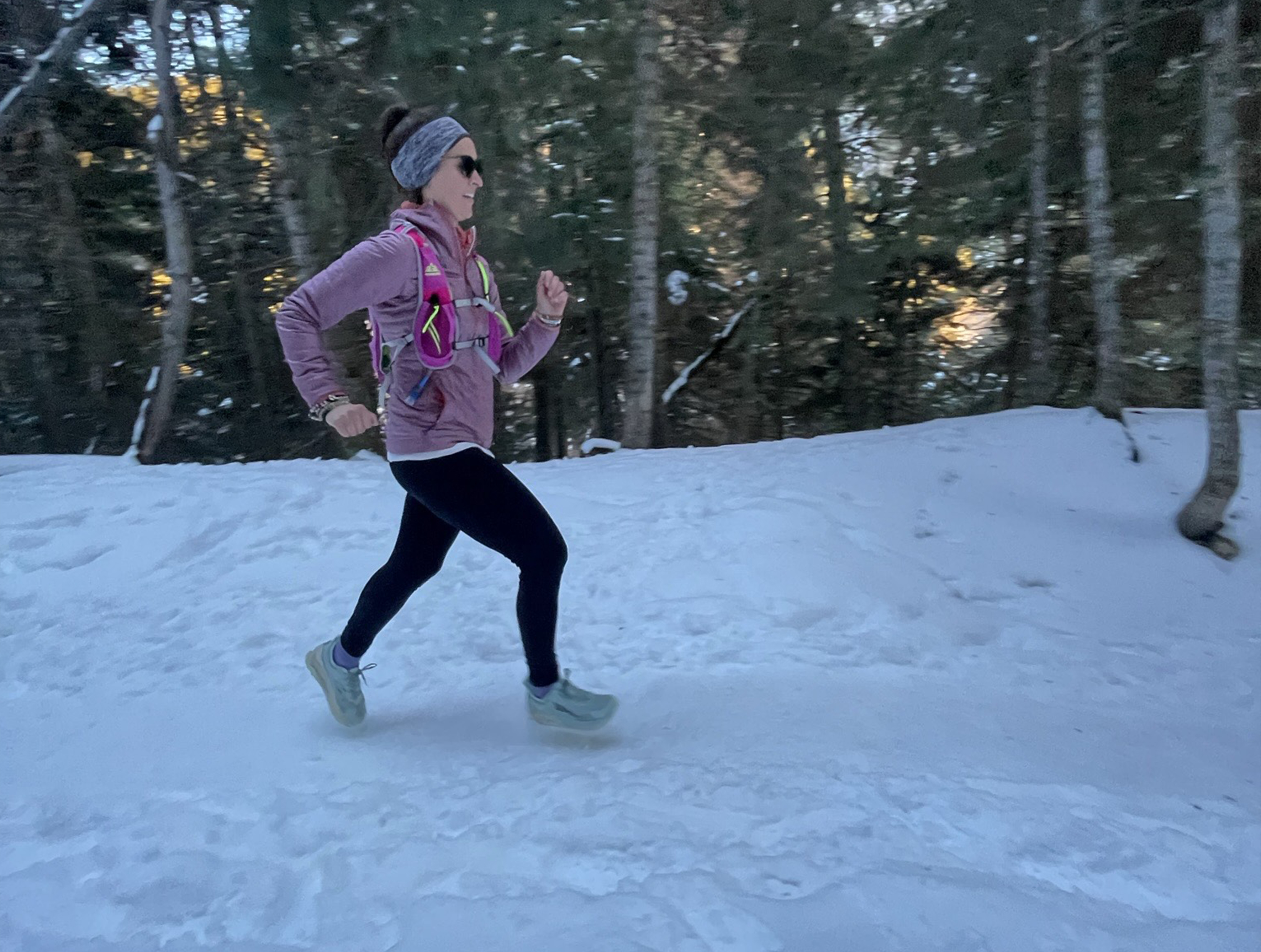
Jack Parke
Despite having a history of runner’s knee and a torn meniscus on her left side, Corr noted no knee issues with the Altra Olympus. However, she reported that the looser fit around the midfoot could mean individuals with weak ankles may be more prone to rolling them.
Best Minimalist: Xero Scrambler Low
Tester Report Card
- Total Mileage: 75 miles
- Toughest Run: 10 miles with 2,000 feet of elevation gain
- Verdict: Tester plans to continue wearing the shoes
Specs
- Available Sizes: Men’s 6.5-15; women’s 5-12
- Fit: Very wide
- Stack Height: 19mm
- Arch Support: None
- Toebox: Very wide
- Sole: Level
Pros
- Similar roomy fit to the original Altra Lone Peak
- Lightweight
- Balance of protection and ground feel
Cons
- Somewhat lower stack height may be a tough adjustment for maximalist runners
- No velcro tab on the back heel to match the gaiter hook on the front
Dustin Adair, who clocks in upwards of 40 miles of trail running a week, was once a committed Altra fan. “I was married to Lone Peaks for a long time but over the last few years they’ve made some changes and the shoe just doesn’t fit the same,” he told me. “I’ve made many trips to the running shoe store, tried on many different kinds of shoes, in hopes of finding the ‘golden shoe’ again.” This sentiment reflects a broader shift in Altra shoes, as the brand has incrementally trimmed down the wide fit of their shoes over the years, leaving the original fan base in a lurch.
This tester wasn’t interested in going maximal (“hate the Hoka”), but what about trying out a barefoot-style shoe? If the Altra Lone Peaks have the lowest stack height (25mm) of a more traditional running shoe, the Xero Scrambler Low has one of the higher stack heights (19mm) of barefoot-style shoes. It’s also the brand whose fit mostly closely resembles that of the original Altras. Could this be the Altra Lone Peak alternative my tester was looking for?
“These Xero shoes are now the closest I’ve come [to the Lone Peak],” he reported. “I loved the way these shoes fit my feet.” Like the Lone Peaks, the Xero Scrambler Low is lightweight, breathable, and very stable.
While he did notice the ground with the Xero Scrambler Low as compared to the Altra Lone Peak, he found this to be an improvement on the original shoe. Even when clocking 10 miles and 2,000 feet of vertical gain on trails that were a mix of dirt and rock, the balance of ground feel and cushion was on point. If my tester had any criticism, it’s that he wanted to see a velcro strip on the heel to match the gaiter clip on the front of the shoes.
Best Support: Topo Magnifly 5
Tester Report Card
- Total Mileage: 50 miles
- Toughest Run: 8 miles
- Verdict: Tester plans to keep wearing this shoe (but will size up in the future)
Specs
- Available Sizes: Men’s 8-14; women’s 6-11
- Fit: Runs short but wide, plan to size up if you are in between sizes
- Stack Height: 25mm
- Arch Support: Yes
- Toebox: Wide
- Sole: Toe spring
Pros
- Great traction
- Offers plenty of cushion for a reasonably low stack height
- Good durability
Cons
- Toebox was narrower than our tester prefers
- No wide offering
Another brand that holds its own in the zero-drop space is Topo. While not all of Topo’s shoes are zero-drop, many of them are low drop (they are also one of the few brands that lets you drill down by drop on their website, so kudos for that), which offers some flexibility for individuals who don’t mind a couple of millimeters at the heel.
Katie Hill tried out the Topo Magnifly to see how it would compare to her typical Altra Timps or Escalantes. She switched to zero-drop running shoes a couple of years ago to help in creating a natural gait to reduce the risk of injury in the long-term. Most recently, Katie has been dealing with some IT band syndrome in her right knee.
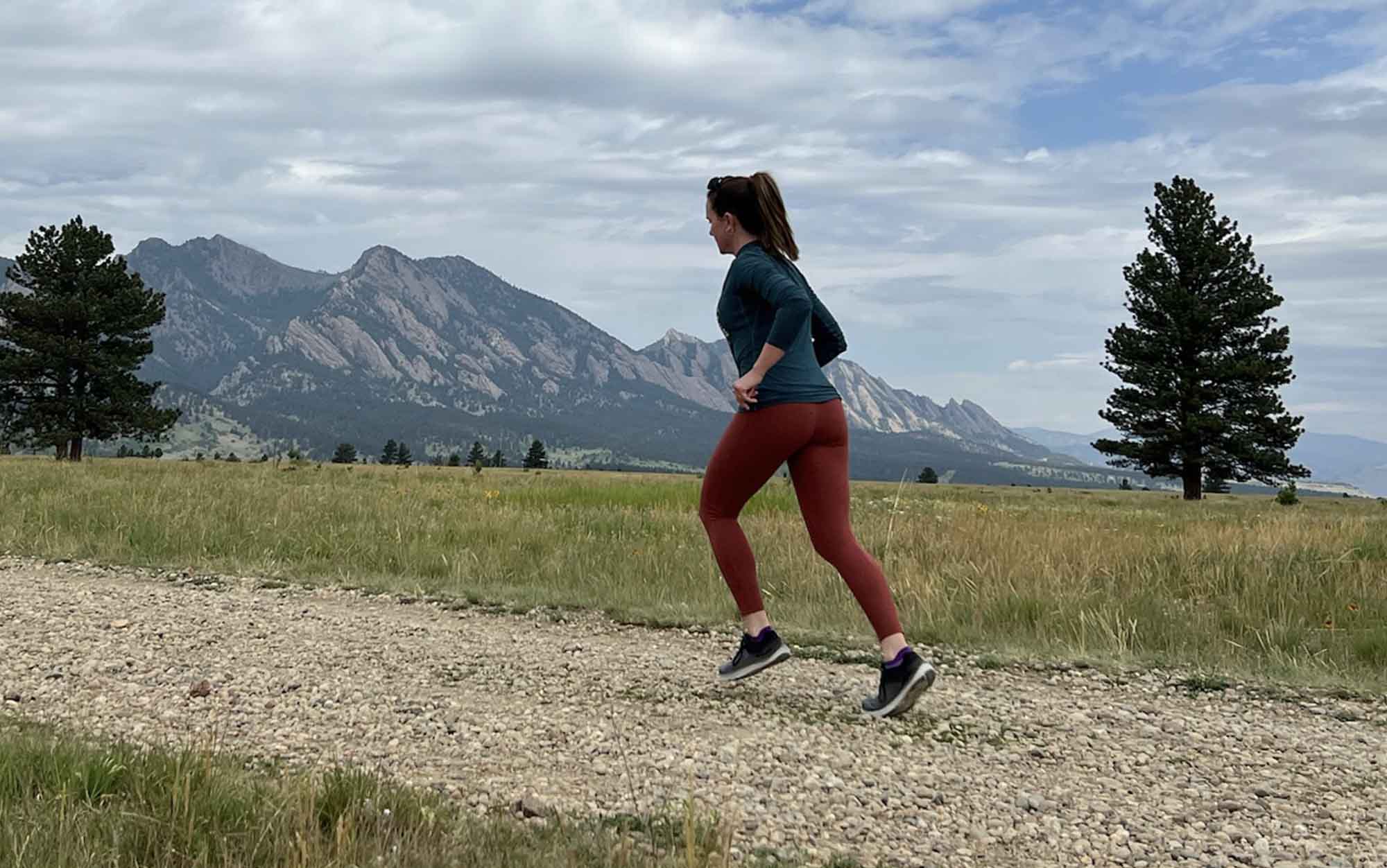
Katie Hill
After 50 miles of testing on roads and trails in the early summer heat of Austin, Texas, there were aspects of this shoe she appreciated, and others she did not. The pronounced arch support — a major difference between Altras and Topos — felt “lovely on my midfoot.” The amount of foam in the shoe offered a nice balance between cushion and ground feel. She also noted that “the tread is a little wider through the midfoot and the heel than on an Altra, where the tread really tapers with the foot shape,” which helped make the shoe feel more stable overall. The extra tread also made this a good choice for those days when her runs took her between pavement and city trails. Finally, the durability of this shoe showed a lot of promise. After 50 miles of running, the outsole still looked great, and was holding its tread well. The upper looked virtually new.
Katie reported that as someone with a wide foot, she was able to wear the Magnifly (which isn’t yet offered in wide), but wishes that the toebox had been a bit wider. The comparative lack of the room in the toebox somewhat contributed to the development of blisters during the unusually sweaty weeks she spent testing this shoe.
Best for Trail Runs: Altra Timp 5
Tester Report Card
- Total Mileage: 20 miles
- Toughest Run: 7.5 miles with 3,300 feet of elevation gain
- Verdict: Tester plans to continue wearing the shoe
Specs
- Available Sizes: Men’s 7-15; women’s 5.5-12
- Fit: Wide
- Stack Height: 29mm
- Arch Support: None
- Toebox: Very wide
- Sole: Toe spring
Pros
- Plenty of cushioning and protection for trail runs
- Great traction
Cons
- Picks up dirt and wear somewhat quickly
There are plenty of runners that have tried out a pair of Altra Lone Peaks and found that the comparatively lower stack height wasn’t for them. OL’s associate editor, Ashley Thess, is one of them. But she’d been casually running in the comparatively low heel drop of the Topo Ultraventure (5mm) for a few years, and was game to try a zero-drop Altra that had a more robust stack height.
Enter the Timp. Compared to Ashley’s go-to shoe, it has an extra 4mm of cushion at the forefoot, but a comparative stack height at the heel. She took the Timps out for a couple of rounds of what she calls her “backyard mini”: a 4-miles, 2K elevation climb up Mount Wire from Salt Lake City. Then she took it out for a 7.5-mile run up 3.3K of vert with dry dirt and rock scrambling. Finally she tackled over 2,500 feet of elevation gain over a mile in a serious scramble that usually calls for approach shoes.
Not only did Ashley report having no Achilles tendon issues (impressive for losing 5mm of heel drop while adding in so much elevation gain), she actually felt like it helped her outer IT band knee pain (a souvenir from her days as a dog walker), saying “I still get stiff but not like before.” Ashley was already a mid-foot striker even with the heel drop, so the main biomechanical difference she noticed in her stride was that her feet were landing closer together underneath her body than they had been previously. As someone with flat arches, she reported that she didn’t even clock the lack of arch support in the Altras.

Ashley Thess
Compared to her typical Topos, Ashley described the Timp’s “standard” fit as snug, with just enough room in the toebox. The extra cushion at the midfoot and forefoot, along with the stiff outsole, protected her feet while pounding out the miles over jagged rocks. She also liked that this shoe featured the Vibram Megagrip outsole, which gave her plenty of grip on steep trail sections. Ashley did note, however, that the higher stack height meant she was slightly more apt to roll her ankles in these shoes than in her standard Topos.
Best for Big Miles: Altra Mont Blanc Carbon
Tester Report Card
- Total Mileage: 60 miles
- Toughest Run: 8 miles with 4,000 feet of elevation gain
- Verdict: Tester plans to continue wearing the shoe
Specs
- Available Sizes: Men’s 7-15; women’s 5.5-12
- Fit: Wide
- Stack Height: 30mm
- Arch Support: None
- Toebox: Very wide
- Sole: Toe spring
Pros
- Lightweight for the amount of cushion they are providing
- Higher stack height reduces ground feel on long days
Cons
- Not quite enough volume in the toebox
- Less durable
Ultrarunner Judith Roel picked one of the few zero-drop shoes that also incorporates a carbon plate in the sole, but I was more curious about how this experienced runner would respond to the lack of arch support and change in drop from her typical Brooks shoes (the Ghost, with a 12mm drop and the Cascadia, with an 8mm drop). Just fine, as it turns out: Judith reported that after a couple of short runs “my feet felt really great in them.” And it wasn’t just her feet, lingering pain in her left calf from an old tear injury was also not an issue in these shoes.
Even with the carbon plates, these weren’t the fastest shoes Judith had used (those would be the Hoka Rockets and Speedland GS:TAMs), but she was won over by how easy it was to run in these shoes. “I don’t think I can go back to regular running shoes after getting used to how gentle these are on my fatigued legs after hard weekends.” While Judith attributed this to their light weight, it’s also possible that she was experiencing a shift in how her body’s mechanics were working. With her Achilles able to fully extend, it was absorbing more of the impact of each footfall, instead of transferring all of that load up the kinetic chain. And this stayed true whether she was running 3 miles or 13 miles.
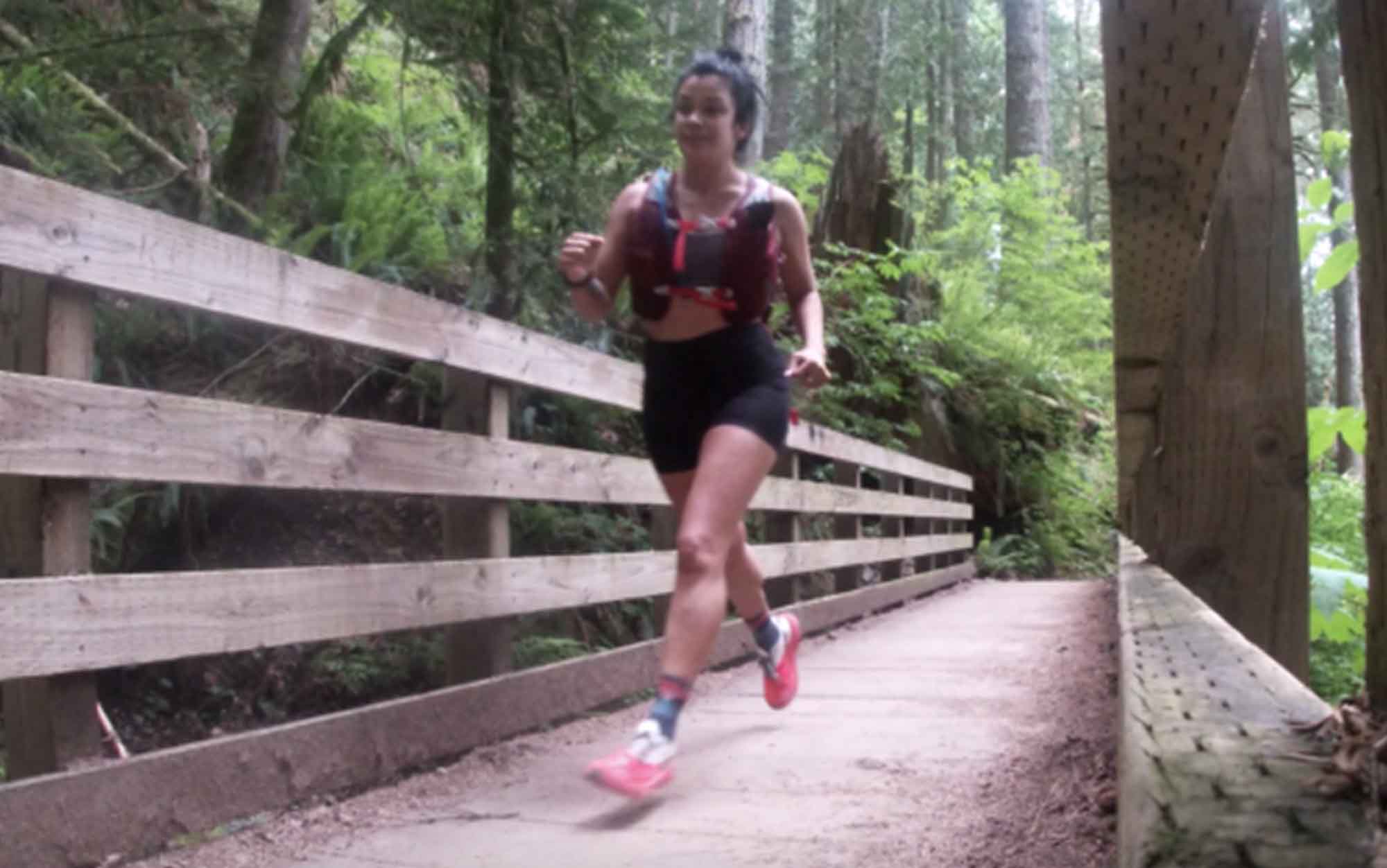
Judith Roel
Judith did report some problems with fit, particularly the interior volume of the toebox, which contributed to some blisters before the shoes were fully broken in. She was also less than impressed with the shoe’s overall durability (a common refrain when it comes to Altra). But these were minor quibbles compared to their light weight, overall comfort, and traction on tough climbs. Right now, they are her top pick to take to France in the fall to run the 469-mile Le Chemin de Puy.
Best Barefoot: Merrell Vapor Glove
Tester Report Card
- Total Mileage: 125 miles
- Toughest Run: 21 miles
- Verdict: Tester plans to continue wearing the shoe
Specs
- Available Sizes: Men’s 7-15; women’s 5-11
- Fit: Standard
- Stack Height: 6mm
- Arch Support: None
- Toebox: Wide
- Sole: Level
Pros
- Affordably priced
- Great traction with a good toe guard
- Lightweight
Cons
- Brand struggles with consistency in fit with each iteration
Barefoot shoes start with a zero-drop, but then take it a step further: no arch support, a wide toebox, and a stack height so low it should feel like you are walking directly on the ground. The idea here is that by allowing your feet to work as nature designed them, you can reduce your risk of long-term injuries.
Read Next: The Best Barefoot Shoes
If you’re new to the world of zero-drop shoes, this may not be where you want to start, but if you’ve noticed a positive change in your running mechanics since switching to zero-drop, it may be worth experimenting with a barefoot shoe to see if it would benefit your running form.
Zach Zenteno has been using barefoot shoes as part of his running regime for several years to help keep a plethora of injuries (shin splints, metatarsalgia, calf strain, knee pain) at bay while training for marathons and, now, his first ultra. “My go-to road shoe was the Vivobarefoot Primus Lite 3, but on trail, my go-to is still the Altra Lone Peak. Though I love barefoot shoes, long runs (10+ miles) on rugged terrain, especially downhill, is a challenge. I’ve learned this one the hard way.”
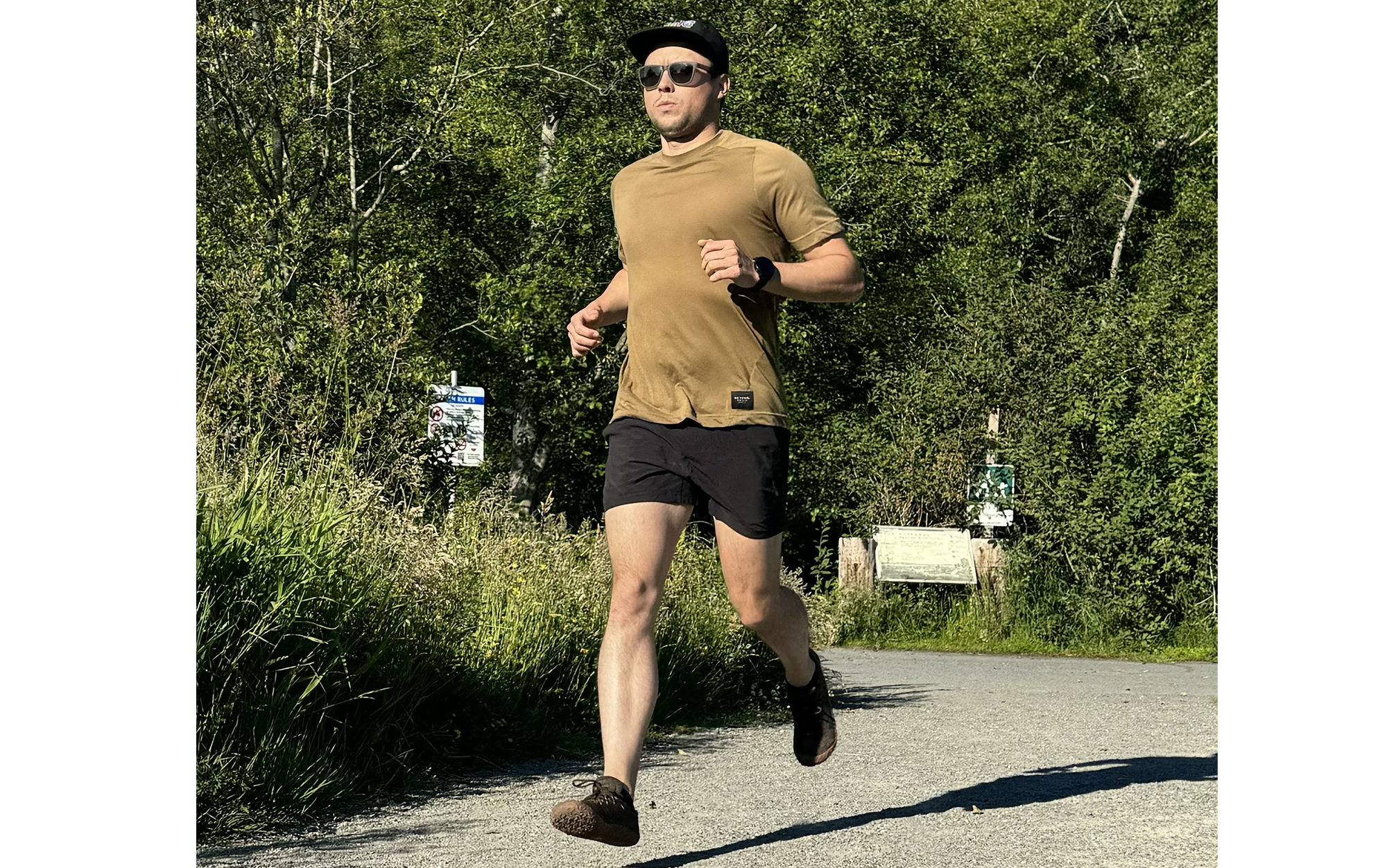
Zach Zenteno
Merrell has been making barefoot-style shoes since the beginning, but have struggled with consistency compared to more popular mainstream brands like Vivobarefoot and Xero. Zach tried out the latest version of the Vapor Glove, which is a barefoot-style zero-drop shoe with a 6mm stack height. (Merrell also makes the Trail Glove, which has a 14mm stack height and [LL asking about arch support].)
After running 125 miles in these shoes over a combination of low-keys trails and sidewalks, the Merrell Vapor Glove has become Zach’s new go-to. First off, he found that the fit was, for his self-described typical feet, better than with Vivobarefoot. “I love the way these shoes hug my heel and mid-foot,” he said. “No slipping around inside of the shoe.” Unfortunately, the toe box was a little on the narrow side. “While I appreciated the more secure fit, having more room for my toes to spread would be nice.” This tester also appreciated the balance of comfort with ground feel. While the insole of these shoes does have a trace of cushion, Zach “could feel the ground with each step, which was compounded by the snug, glove-like fit. Rocks, roots, sidewalk lines were all noticeable and that’s what I want in a barefoot runner.”
But what really won him over was the traction on the Vibram outsole, which has 2mm lugs. “I could hammer downhill sections of sidewalks and asphalt with full confidence,” he said, noting that they were exceptionally sticky. Trail traction wasn’t quite at the same level, with some slipping on dry trails with loose rocks. Zach also appreciated the robust toe guard on the Vapor Gloves. “On my first-ever run in the Merrells, I drilled a rock pretty dang hard with my foot, head-on,” he told me. “The Vibram outsole extends over the toe cap a bit. This was enough to spare my toes on this collision.” At the end of his 125-mile testing, the tread was starting to wear some, although the rest of the shoe was in great shape.
Best Traditional: Inov-8 Trailfly G 270
Tester Report Card
- Total Mileage: 14 miles
- Toughest Run: 7 miles through deep mud that sucked the shoes up to their shoelaces
- Verdict: Tester plans to continue running in the shoe
Specs
- Available Sizes: Men’s 7-15; women’s 5.5-11
- Fit: Narrow
- Stack Height: 22mm
- Arch Support: Yes
- Toebox: Standard
- Sole: Toe spring
Pros
- Great traction on slippery surfaces
- Plenty of interior height
Cons
- Narrow outsole gave the impression of the tester’s foot hanging off the side
While zero-drops are most often found in running shoes with other natural-movement features — no arch support, a wide toebox, no rocker bottom or toe spring — the Inov-8 Trailfly G 270 is a fairly traditional running shoe. This one has plenty of arch support. A pretty standard toebox. It even has a toe spring on an outsole that is veering into rocker bottom territory.
OL contributor Katie Hill tested the Inov-8 Trailfly G270 while recovering from IT band syndrome on her right side. She typically runs muddy creek trails in Texas in Altra Escalantes or Lone Peaks (standard shoes for runners who prefer natural movement features) and noted right away that the toebox on the Trailfly G270 was noticeably narrower. Fortunately, the width elsewhere was comfortable and the interior volume of the shoe was surprisingly roomy.
One thing that stood out to Katie was how much more structure and stability the Traifly G 270 has compared to her typical zero-drop shoes of choice. Katie was impressed, too, with the shoe’s traction on muddy and slippery surfaces. “Even after crossing calf-deep creeks and running through muddy bogs, there was little compromise to the shoe’s grip on rocks and rooty trails in the miles that followed,” she said. “The creek crossing was full of slippery rock snot, but the shoe stayed pretty stable underwater.” Because of the narrow structure of the outsole, it felt at times as if her heel were hanging over the side of the shoe. While she did not roll her ankle in even the slippery conditions previously described, she did report some additional fatigue with the stability muscles in her ankles and along her Achilles.
Things to Consider Before Choosing Zero-Drop Running Shoes
How to Transition to Zero-Drop Running Shoes
Individuals have a wide range of experiences in transitioning to zero-drop running shoes. Some people can transition almost immediately with no ill effects. For others, it can take weeks or even months of lower mileage running than they are accustomed to. But what remains consistent across the board is the importance of listening to your body. There is more load and more stretch that your Achilles tendon has to absorb when you are wearing zero-drop running shoes.
How extreme this feels will depend in part on what shoes you currently wear in your day-to-day (including casual shoes). If you wear running shoes with a high heel drop and dress shoes with lifts or high heels, then you will likely feel more strain when first wearing zero-drop running shoes. However, if you are typically walking around in flats or barefeet, and coming to zero-drop running shoes from a 4mm or 5mm drop shoe, the effect will be more negligible.
Read Next: It’s Time to Give Barefoot Shoes a Try
If you’re on the more extreme end, start by taking a short walk in your zero-drop running shoe, and assess how your calf feels the next day. As you start to adjust to walking, you can begin to add in short runs, always assessing not only how your calf feels in the moment, but how it feels the following day. By transitioning slowly and mindfully you will reduce the odds of developing an overuse injury like Achilles tendonitis.
Benefits of Zero-Drop Running Shoes
If you are standing upright and barefoot on the ground, your feet are on a level plane. If you start to slowly shift to the balls of your feet, you’ll notice that your hips have to start slowly rotating forward to keep your body upright. That’s also happening when you are wearing shoes with a lift in them, including high-drop running shoes. So one of the first benefits to wearing zero-drop running shoes is that it improves your posture.
Many individuals may be natural midfoot or even forefoot strikers and not know it. That’s because high heel drops can force heel strikes by changing the angle at which the bottom of your shoe touches the ground. For some people, heel striking can lead to excessive impact on their knees. Midfoot and forefoot striking moves that load to the Achilles tendon instead.
While many people suffer from Achilles tendonitis and other Achilles-related overuse injuries, carefully and mindfully strengthening the Achilles tendon to handle a heavier load (which it is designed to do) can help prevent this.
Other Natural Movement Features
While zero-drop running shoes often feature other natural movement features, some do not feature any, and some feature only a few. Decide which features you are interested in, and which you would rather avoid, before making a final purchase.
Level Sole
A sprung toe or rocker bottom is often added to running shoes to assist with tight toes or ankles. However, they can also inhibit the gait cycle. Many zero-drop running shoes are flat across the bottom of the foot.
Low Stack Height
A low stack height will help you to feel the ground better as you run, and will promote a lighter footfall. However, some individuals find that their feet, at least at first, will fatigue easily.
No Arch Support
Many zero-drop shoes have no built-in arch support. By removing arch support, the muscles of your foot and your plantar fascia will expand and contract as you run, absorbing some of the load of each footfall. However, if you have been wearing shoes with arch support for years, these muscles may not yet be strong enough to support the load. If you want to make this switch, plan to ease into these shoes very gradually.
Wide Toe Box
A wide toe box will allow your toes to spread out as you run. This can help with balance (a wider platform to land on with each footfall) and with engaging the muscles of your feet as you roll through the gait cycle. Some people, however, may prefer a “locked in” feeling while running and wide toe boxes are not always appropriate for other disciplines, such as climbing.
Overall Width
Zero-drop running shoes are also often wider than typical running shoes. This allows for the muscles of your foot to engage more fully as you roll through the gait cycle. However, individuals with naturally narrow feet sometimes may feel that their feet are slipping around inside their shoes.
FAQs
A zero-drop shoe has the same amount of cushion at the toebox as it does at the heel. There is no extra cushion to create an elevated heel.
Many people find that zero-drop shoes positively impact their running experience by improving their posture, promoting a midfoot or forefoot strike, and reducing the load on their knees. However, some people find that zero drop shoes put more strain on their calf muscles and Achilles than they would like.
While zero-drop and barefoot are treated as synonyms, zero-drop is only one characteristic of a barefoot shoe. A true barefoot shoe has a low stack height, no structure (or arch support), a level sole, and a wide toebox.
It can take anywhere from a couple of days to a couple of months to adjust to zero-drop running shoes, depending on the heel drop you are coming from and the current length and strength of your Achilles tendon. Some may have to transition more slowly than others, especially if they are coming from a high-drop running shoe. Some individuals have had success transitioning first to a low-drop running shoe before attempting zero-drop. If you are actively suffering from Achilles tendonitis, it may be best to let that heal before attempting a zero-drop shoe.
Final Thoughts on the Best Zero-Drop Running Shoes
After hundreds of miles of testing, it’s clear that wherever you are staring from, whatever your goals, there is a zero-drop running shoe that can meet your needs. Our testers ranged from barefoot diehards to committed maximalists, and here are their recommendations
- Altra Lone Peak (Men’s) (Women’s)
- Most Cushioned: Altra Olympus (Men’s) (Women’s)
- Best Minimalist: Xero Scrambler Low (Men’s) (Women’s)
- Best Support: Topo Magnifly 5 (Men’s) (Women’s)
- Best for Trail Runs: Altra Timp 5 (Men’s) (Women’s)
- Best for Big Miles: Altra Mont Blanc Carbon (Men’s) (Women’s)
- Best Barefoot: Merrell Vapor Glove (Men’s) (Women’s)
- Best Traditional: Inov-8 Trailfly G270 (Men’s) (Women’s)
The post The Best Zero Drop Running Shoes of 2024, Tested and Reviewed appeared first on Outdoor Life.
Source: https://www.outdoorlife.com/gear/best-zero-drop-running-shoes/


